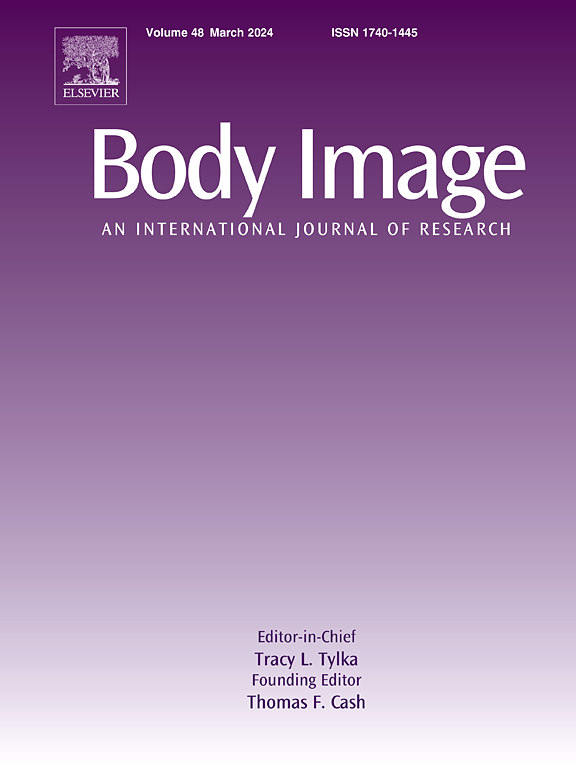State affect and body image effects of body positive social media content within a female chronic illness sample
IF 5.4
1区 心理学
Q1 PSYCHIATRY
引用次数: 0
Abstract
Body positivity refers to a movement, popularized on social media, that encourages the normalization and acceptance of bodies diverging from sociocultural ideals, specifically within marginalized communities. Previous studies suggest that briefly viewing body positive social media content may lead to increased body satisfaction and positive affect in young women relative to thin-ideal and appearance-neutral content. Diminished body functionality and appearance change due to chronic illness poses a unique challenge to positive body image in young adults living with chronic illness. Typical body positive social media content may not be useful for this community since chronic illnesses are often not outwardly depicted, so the current study aimed to examine the state effects before and after viewing body positive social media content in a sample of young women (N=201) with at least one self-reported chronic illness. Participants (Mage = 29.4, SD = 6.74; 79.2 % white) were randomly assigned to view one of two sets of 10 images: chronic illness body positive and typical body positive. Participants completed a Visual Analogue Scale (VAS) pre- and post-stimuli exposure. Findings from repeated measures ANOVA revealed significant interaction between time and group for negative affect (F(1198) = 4.402, p =.037) and broad conceptualization of beauty (F(1199) = 4.288, p =.040), such that those exposed to the chronic illness stimuli reported a larger reduction in negative affect and an increase in conceptualization of beauty beyond the non-chronically ill ideal post-exposure. Thus, exposure to body positive social media content inclusive of chronic illness may be more useful in stabilizing affect and promoting greater positive body image within the community. These findings highlight the importance of inclusive body positive portrayals in terms of dimensions beyond weight and shape to account for the effects of diminished body functionality.
在女性慢性病样本中,身体正面社交媒体内容对状态情感和身体形象的影响。
身体积极性是指在社交媒体上流行的一种运动,它鼓励人们,特别是边缘化群体,将与社会文化理想相左的身体正常化并予以接受。以往的研究表明,相对于瘦身理想和外貌中性的内容,短暂浏览身体正面的社交媒体内容可能会提高年轻女性对身体的满意度和积极情绪。慢性疾病导致的身体功能减退和外貌改变对患有慢性疾病的年轻成年人的正面身体形象构成了独特的挑战。典型的正面身体形象社交媒体内容可能对这一群体没有帮助,因为慢性疾病通常不会被直观地描述出来,因此本研究旨在研究至少患有一种自我报告的慢性疾病的年轻女性(N=201)在观看正面身体形象社交媒体内容前后的状态影响。参与者(年龄 = 29.4,SD = 6.74;79.2% 为白人)被随机分配观看两组共 10 张图片中的一张:慢性病身体正面图片和典型身体正面图片。受试者在刺激前和刺激后填写视觉模拟量表(VAS)。重复测量方差分析的结果显示,时间和组别对负面情绪(F(1198) = 4.402, p =.037)和广义的美感概念化(F(1199) = 4.288, p =.040)有显著的交互作用,因此那些接触过慢性疾病刺激的人在接触后报告的负面情绪减少幅度更大,美感概念化的增加幅度也超过了非慢性疾病的理想状态。因此,接触包含慢性疾病的积极身体社交媒体内容可能更有助于稳定情绪,并在社区内促进更积极的身体形象。这些研究结果强调了在体重和体形之外的其他方面对身体进行正面描绘的重要性,以解释身体功能减退的影响。
本文章由计算机程序翻译,如有差异,请以英文原文为准。
求助全文
约1分钟内获得全文
求助全文
来源期刊

Body Image
Multiple-
CiteScore
8.70
自引率
28.80%
发文量
174
期刊介绍:
Body Image is an international, peer-reviewed journal that publishes high-quality, scientific articles on body image and human physical appearance. Body Image is a multi-faceted concept that refers to persons perceptions and attitudes about their own body, particularly but not exclusively its appearance. The journal invites contributions from a broad range of disciplines-psychological science, other social and behavioral sciences, and medical and health sciences. The journal publishes original research articles, brief research reports, theoretical and review papers, and science-based practitioner reports of interest. Dissertation abstracts are also published online, and the journal gives an annual award for the best doctoral dissertation in this field.
 求助内容:
求助内容: 应助结果提醒方式:
应助结果提醒方式:


